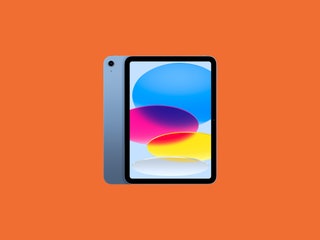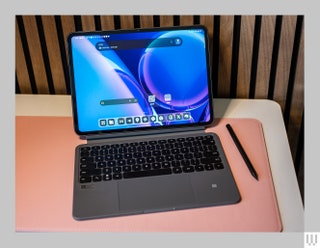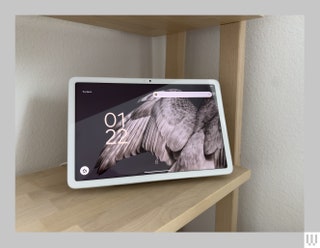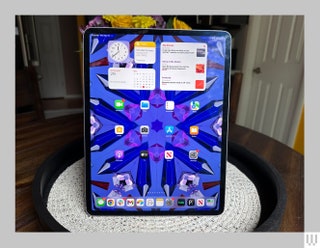The Best Tablets for Work and Play
If you buy something using links in our stories, we may earn a commission. Learn more.
The best tablet can be a portable TV screen around the house and a way to get light work done away from your desk. They're not essential but are nice to have around. With a wealth of apps for drawing, painting, and making music, they’re also a great outlet for creative impulses.
The iPad’s ease of use and best-in-breed software make it the obvious choice for most people, but if you don’t want an iPad, there are other options. Android tablets have made a comeback in the last couple of years. Amazon’s Fire tablets are also an affordable way to watch movies and browse the web, as long as you don’t mind their limitations. There are even great E Ink slates for jotting down notes or sketching. We've tested dozens of tablets over the years, and these are the best right now.
Check out our other tablet guides, including the Best iPads, Best Digital Notebooks, Best Drawing Tablets, Best Kids' Tablets, Best iPad Accessories, and Best Fire Tablets.
Updated November 2024: We’ve added the Samsung Galaxy Tab S10 series, iPad Mini, ReMarkable Paper Pro, Honor Magic Pad 2, Poco Pad, and Amazon Fire HD 8.
Power up with unlimited access to WIRED. Get best-in-class reporting that's too important to ignore for just $2.50 $1 per month for 1 year. Includes unlimited digital access and exclusive subscriber-only content. Subscribe Today.
Do You Actually Need a Tablet?
It depends! If you already have a laptop and a smartphone, it could feel redundant. But if your family member or loved one is hogging the TV, it's nice to be able to hold a big screen in your lap and catch up on your favorite shows, and even bring it along to every room in the house. Some tablets with accessories like keyboard covers and styli are also capable of handling some light work and might make great travel computers, and while some people may be able to fully replace their laptop with them, it's not for everyone.
Things to Consider When Shopping for a Tablet
Display size: The biggest factor to consider when shopping is size. Tablets usually range between 8- and 14-inch screens, with common sizes falling somewhere in the middle. A 14-inch screen might sound great until you start carrying it everywhere. It's big, and using the touchscreen can be unwieldy. I prefer tablets around 10 inches because the screen is large enough to feel distinct from my phone and it's not painful to operate.
Kid-friendly tablets: Is this tablet for a kid? You may want to take a look at Amazon's Fire HD Kids tablets as they come with a thick case and Amazon offers a worry-free two-year warranty—if they break the tablet in that time, Amazon will send you a new one no questions asked. However, if you want to stick with an iPad or Android tablet instead, there are settings you can dig into to set up parental controls and limit what they can access. We have a parental controls and screen time guide for Apple, Google, and Microsoft accounts.
Cellular connectivity: Do you need your tablet constantly connected to the internet, even when you're out and about? Typically only midrange and high-end tablets have the option of cellular connectivity (you'll have to pay for a data plan through your carrier). If you're planning on using it for work, then it might be a good idea, but you can always try and rely on the coffee shop's Wi-Fi network (just make sure it's secure). If you're only away from Wi-Fi a few moments while using the tablet, consider turning your smartphone into a hotspot. It might not be as fast, but it's cheaper and does the job.
Accessories: Some tablets have a much bigger accessory ecosystem than others. iPads have so many cool accessories that enhance the tablet experience, some of which are universal, but you won't find as many purpose-built accessories for Android or Windows tablets. Keep an eye on what the tablet manufacturer offers—likely a folio case, keyboard cover, or stylus—as it might be your best bet.
Software support: A tablet is like a laptop—you're not upgrading it every year, more so once every four to five years. That's why software updates matter. Apple supports its iPads the longest, though some features may not be available to certain models. Still, it helps maintain the device's security and keeps it bug-free. Samsung and Google have lengthy update cycles too, though not nearly as long as Apple. Keep a look out for this as you shop.
iPadOS vs. Android
The two prevailing tablet operating systems are Apple's iPadOS and Android. iPads are much more common in this space because Apple has been iterating on the software for more than a decade. Google, on the other hand, has had a spotty relationship with tablets—it came out the gate strong and then all-but abandoned development for bigger screens until very recently. There's renewed interest in Android tablets as the software experience is much better and optimized for bigger displays. Some Android tablet makers even have desktop modes that try to simulate a laptop experience, like Samsung's DeX mode.
If you're already in Apple's ecosystem and own an iPhone, MacBook, or Apple Watch, an iPad is a no-brainer. Apple's hardware complement each other—like how you can even use an iPad as an external monitor with a MacBook. And even if you use an Android phone or Windows desktop, an iPad still offers the best tablet experience. However, if you hate iPadOS (or Apple), or just want to stick with the same Android app ecosystem as your smartphone, the multitasking experience has improved and there are a few great Android tablets to consider.
Other Tablets to Consider
We test tons of tablets every year. Here are a few others we like, just not as much as our picks above.
OnePlus Pad for $300: The OnePlus Pad has a successor, but OnePlus says it will continue to sell the OnePlus Pad until stock runs out. It's great value at the frequently discounted price of $300 (8/10, WIRED Recommends). Multitasking is notably efficient, aided by the company's accessories: a Magnetic Keyboard case and a stylus. It was the first time I felt comfortable working for long stretches on an Android tablet. The 11.61-inch LCD 144-Hz display is sharp, fluid, and colorful, the battery can last nearly a full workday, and performance is smooth. It's a shame there's no microSD slot, headphone jack, or biometric authentication.
Samsung Galaxy Tab S9 FE Plus for $500: The Galaxy Tab S9 FE is the “Fan Edition” version of the flagship Tab S9 series, meaning it makes some sacrifices for a more palatable price. It comes in a Plus and standard variant—I tested the former—and both include a stylus. It performed much better than the older Tab S7 FE tablet I tested with fewer stutters. The 12.4-inch LCD screen is large and a rarity to find at this price in the world of Android tablets, but it's a bit tricky to comfortably hold, especially when browsing apps in bed. It has dipped as low as $400 before, so try to catch it on sale.
Samsung Galaxy Tab S9 Series for $600+: The 2023 Galaxy Tab S9 series (7/10, WIRED Recommends) consists of three tablets: the Tab S9 ($600), Tab S9+ ($950), and Tab S9 Ultra ($900). They're all expensive, though prices have come down since their release. The hardware is still excellent and, considering the new Tab S10 series isn't dramatically different, the Tab S9 series is still worth a look. They sport superbright 120-Hz screens and IP68 water resistance, and Samsung includes the S Pen stylus.
Amazon Fire HD 10 (2023) for $140: This Amazon tablet drops to $75 on sale, and that's a hard-to-beat price. The update over the 2021 model is largely just a processor bump, making it slightly faster. Its performance is decent (get the keyboard bundle if you plan to do some light typing tasks).
Barnes & Noble Nook 9-Inch Lenovo Tablet for $150: Want a cheap Android tablet with the Google Play Store (aka, not an Amazon Fire Tablet)? Check out the new Nook from Lenovo and Barnes & Noble (6/10, WIRED Review). It runs Android 13 and isn't a powerful machine, but it's adequate for browsing social media, reading, and catching up on some shows.
TCL Tab 10 Nxtpaper 5G for $240: You can only buy this TCL slate if you are a Verizon customer, which is disappointing, but it's an otherwise pretty nice Android tablet for the money. The star of the show here is TCL's Nxtpaper technology, which offers a matte, glare-free display that's easy on the eyes. It does have a backlight, unlike some previous versions, so you can use it in any lighting. Performance has been pretty solid overall, I haven't seen too much lag as I browse the web or scroll through Instagram, and it has excellent standby battery life. The 5G option is a nice touch if you want connectivity wherever you go.
Poco Pad for £430: This affordable tablet from Xiaomi’s fun budget sub-brand has a lovely big, sharp 12.1-inch display with a 120-Hz refresh rate and four stereo speakers around the sides. The Poco's build quality is impressive for the price, though it is quite bulky and heavy, and it’s ideal for watching movies or casual gaming in bed. Performance gets stretched if you play anything too demanding, and HyperOS on top of Android 14 can be clumsy and ugly. The battery life is pleasing, and you can expect several days from the Poco Pad with light use. Unfortunately, it's not currently available in the US. —Simon Hill
Honor MagicPad 2 for £417: This classy tablet is also not currently sold in the US. Quite similar to the OnePlus Pad 2 we recommend above, it boasts a truly gorgeous OLED display with impressive specs (3K resolution, 1,600 nits, 144-Hz refresh rate) that are generally unavailable at this price. Paired with the eight speakers, watching movies and gaming on this tablet is a pleasure. The stylus and keyboard are great (I love the handwriting and formula recognition), but they don’t seem to be available in the UK. I found Honor’s AI features, like Magic Portal, which gets good at predicting what you want to do, very useful, maybe more so on a tablet than a phone. Battery life is good, and charging is speedy (66 watts). The only real weakness here is the limited processing power, which can’t match something like an iPad (though you will pay a lot more for an equivalent Apple device). —Simon Hill
Tablet Accessories
Tablets often don't come with kickstands or enough ports, so it's a good idea to snag a few accessories to enhance your experience. These are some of our favorite tablet accessories, many of which you can also find in our Best iPad Accessories guide.
Satechi Aluminum Desktop Stand for $45: This is my favorite tablet stand, so much so that I've taken it with me on trips. It packs down relatively well, and it is very stable—there's no wobbling around here. You can also adjust the angle quite a bit. It can handle huge sizes too—it worked perfectly with my 12.9-inch iPad Pro.
Logitech K380 Pebble Bluetooth Keyboard for $40: Want a simple Bluetooth keyboard for your tablet instead of spending half the price of your tablet on a keyboard case? I've used Logitech's K380 for years and it's functioned perfectly. It takes two AA batteries that I've yet to replace (Logitech claims two years of use), and you can switch between three connected devices via Bluetooth.
Twelve South Compass Pro Stand for $51: This is made for iPads, but I've had no trouble using it for plenty of other tablets. It's more travel-friendly than the Satechi above and fairly stable, but when I lift the tablet off, the back leg tends to change positions. You can angle it pretty low for sketching or keep it upright for watching movies. Unlike the Satechi, it's not a great option for keeping the tablet upright on a mattress.
Twelve South StayGo Mini USB-C Hub for $60: This works with iPads and other tablets just fine. You can either plug it in and keep it flush with the edge of a slate or use the included cord to keep it extended. You get a USB-C port you can use for pass-through charging, a USB-A, an HDMI, and a headphone jack.
Lamicall Gooseneck Tablet Holder for $22: I've used this on my bed frame to hold up various tablets for more than a year. The gooseneck requires a bit of finagling to get to the right position, and if you're constantly tapping the tablet, it will jiggle around. But it's a great hands-free way to watch movies. You can affix the clamp to any surface, like a desk or kitchen counter.
Twelve South HoverBar Duo Mount/Stand for $80: You can use this as a stand or as an arm mount, and Twelve South makes it really easy to switch between the two. That means you can easily affix your tablet to your bedside arm mount, and then put it on the stand in your home office in the morning. Both are sturdy, and the arm mount is decently adjustable. Best of all, it doesn't wiggle around as much as the Lamicall above when you tap the screen.
Anker Nano 3 30-Watt Charging Adapter for $20: Most tablets charge at around 18 watts, so this 30-watt charger from Anker is more than capable. The plugs fold up, and it's pretty compact. If your tablet does support faster charging, then I recommend Satechi's 108-watt three-port USB-C charger ($75). This will let you charge your phone, tablet, and laptop all off the same plug.
Einova Ultra Fast Power Bank for $47: This power bank is slim enough to store next to a tablet in your bag, and it has enough capacity (20,000 mAh) to recharge an 11-inch tablet twice. You can fast-charge with the USB-C port and use the two USB-A ports to recharge other devices.




